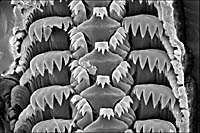CURRENT PROJECTS
Patterns and Processes in the Evolution of Vetigastropoda
The Vetigastropoda includes abalone, top-snails, and keyhole limpets,
along with some lesser-known families. I take a comprehensive approach,
integrating data taken from both fossil and Recent material as well
as molecules (Histone 3, COI, 18S) and morphology to resolve evolutionary
questions. I investigate species to family-level relationships, and
use phylogenies to gain insight into the macroevolutionary processes
of heterochrony, the on-shore/off-shore pattern, and the colonization
of the hydrothermal vent environment.
Heterochrony has historically been invoked in evolutionary scenarios
concerning the vetigastropod family Scissurellidae. This family consists
exclusively of small species (size 1 - 5 mm). Adult scissurellid radulae
very closely resemble those of juveniles of other vetigastropods,
and from this observation it has been inferred that scissurellids
are neotenic forms. However, the striking differences between adult
radulae in the large bodied forms such as Haliotidae, Pleurotomariidae,
and Trochoidea are also consistent with a peramorphic interpretation
of these families from a small ancestral form. Preliminary data indicates
that a small sized ancestor can be reconstructed for all Vetigastropoda. Continuous character state reconstruction is applied to address these questions.
The on-shore/off-shore pattern suggests that lineages originate in
shallow water and are competitively pushed into deeper water over
geological time. It is based on the fossil record of such groups as
sea lilies and the molluscan class Monoplacophora. Conflicting results
have emerged from collaborative work I have carried out on the phylogeny
of some key hole limpets (McLean
& Geiger, 1998). On the phylogenetic tree, some of the predominantly
shallow subtidal forms (Diodora) are found nested within a
clade of deep water representatives (Managnasepta and Cornisepta).
Accordingly, the generality of the on-shore/ off-shore pattern is
called into question. Preliminary data suggest that the hydrothermal
vent environment was colonized repeatedly by vetigastropods.
Monograph of World-Wide Scissurellids
Following a number of publications on Scissurellidae s.l., including description of thus far 25 new species and three new genera (Geiger,
2003, Geiger &
Jansen, 2004a, 2004b, Geiger 2006a 2006b 2006c, Nützel & Geiger 2006, Zelaya & Geiger 2007, Geiger & Sasaski in review),
I continue with a larger project the will result eventually in a monograph
of the family world-wide. I am collaborating with a number of co-workers
on some selected projects (Angel Luque, Emilo Rolan, Bruce Marshall,
Pierre Lozouet), while advancing the comprehensive review.
I am always looking for additional material in any state of preservation:
shells for distribution records and SEM of shell, formalin fixed specimens
for anatomy and histology, ethanol fixed specimens for molecular work.
Please let me know if you have any material even if it is of common
species.
Some first three dimensional reconstructions using Amira software package have been undertaken. Additional work is in progress.
Pea-crabs in Abalone
The frequency of the commensal pea-crab
Orthotheres haliotidis
Geiger & Martin, 1999, was first
thought to be rare, but turns out to be not uncommon. I am collaborating
with Dan Jackson and Nerida Wilson of the University of Queensland on
a more detailed analysis of the biology of this species.
Evolution of Fissurellidae
The keyhole limpets are a highly diverse group with many interesting
modification having occurred during their evolutionary history. Generic
concepts and generic assignments of many species are uncertain, because
the character complexes on which these genera are based are poorly
understood. I am currently in the initial phase of reviewing the approximately
600 species level taxa, and to obtain a handle on fissurellid diversity.







